✨Plugged In: Lorna Williams✨
In a conversation with sculptor, Lorna Williams @lornacwilliams, we discuss the process of becoming and simply being in life and creative practice.
After spending two hours in Lorna Williams' (she/they) studio, I felt a renewed sense of purpose; a reminder that life is less about the destination and more about the journey—the feeling, the growing, the learning, and the being. In a time and landscape where we’re so consumed with results and destinations, we often don’t consider that there is a process of shapeshifting we must endure to become and to arrive. This conversation was my reminder.
As we sat together in her space; humid, earth-toned, and riddled with hidden gems: a fossilized coral reef, human skeleton models, a bin of dental impressions— one being her own, Lorna walked me through her processes of shedding, alchemizing, and continual unlearning. The walls of her studio were filled with bike parts, shelves, and tools; a collection of any mechanical gadget you could think of.
Lorna sits in a wooden swing chair that hangs from the middle of the ceiling with a look of content and peace as she gently rocks in the air, ready for this new journey that awaits her.
Early Career and Shifting Perspective
At 38 years old, Lorna, a New Orleans native sculptor, carpenter, and professional art handler, has journeyed through the arts scene all her life. Lorna’s origin in art-making finds roots in her childhood, through coloring and drawing. While in high school at the New Orleans Center for Creative Arts (NOCCA), she was an avid oil painter, concentrating on the form of the human body. However as time progressed and through influence from her musician classmates, Lorna became more interested in the nuance of the human experience. Deciding those concepts could not be bound to a two-dimensional form, her work needed to expand, triggering a continual season of self-exploration through various mediums.
“I began to pay attention to objects and the body and just these ideas…it was like this, webbing and… line of questioning, like how does it make you feel? How does it smell? How does it taste? Does it make you want to dance? Can visual art installations affect you? Can you choreograph the viewer without them even really knowing?”
From the outside looking in, most artists would die for a career take-off like Lorna’s, early and promising. Throughout her collegiate career, Lorna hopped around through the most elite art programs, curating her learning experience at Maryland Institute College of Art (MICA), Yale University School of Art: Summer Programs, Tyler School of Art, and School of the Museum of Fine Arts (SMFA) searching for a classroom dynamic that would teach her the practical skills while also offering space for exploration of her craft and thesis. Unlike most of her peers, Lorna, in her undergraduate career, was represented by a gallery, had clients, and an arts dealer. The same assignments she submitted for her courses, were exhibited in art fairs and galleries. She approached her career seriously and with intent.
“I was also just a very serious, I'm a serious person…I think, too, things happening for me kind of very early and backwards. It kind of set me apart. I already was having...clients and I had a body of work. I was a name that you could Google and see attached to a gallery and a dealer.”
Lorna’s somberness and depth apply to her art-making process as well, apparent in the complexity of her work. Her orientation towards process, rather than results, allows her space to be present in her physical body throughout her creation process, noting when something excites her or shifts her energy. It informs her line of questioning and investigation, influencing her material choice and method of construction. She isn’t tethered to a specific outcome and is open to pivot at any time throughout the process, welcoming change and challenge.
“I use philosophy and notions and sound and feeling, and all the other arts, all the other elements, to play and make it (the piece) malleable, and break rules, and when that happens…there's a line of questioning… So it's just this ongoing conversation and checking in and being aware of my body…if I feel something in my gut or something's exciting me, or I'm realizing that I'm singing or kind of moving, I pay attention to those things. I don't just get so lost in the zone and it's like I'm floating, I tether myself…”
Her intuition is also fueled by the materials she uses. Her sculptures are filled with found objects—dead insects, wood, plants, root systems, rope, and chains—each serving as a conduit to explore the mimicry of nature in human anatomy. As a studio artist who took on this “folk-ish” way of art-making without much guidance, Lorna underwent a critical period of learning and unlearning herself, along with her geographical and societal landscape to develop her artistic vernacular.

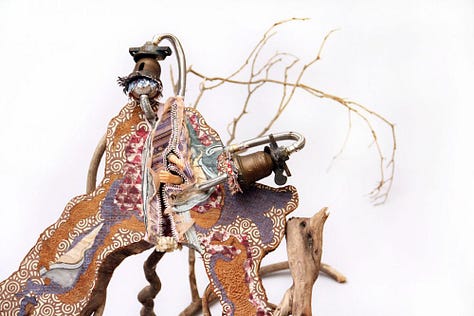
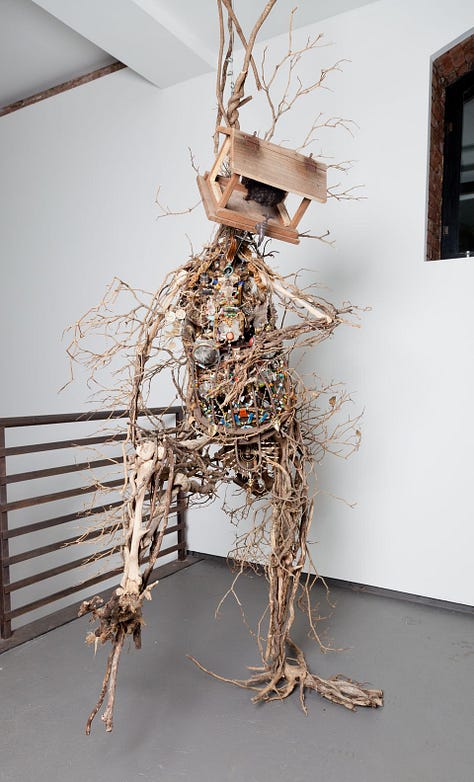
Challenging Identity and Blackness in Art
In my personal experience of living in New Orleans, a small, yet energetically and culturally rich town, creatives of the city often feel tethered to its tradition and past in relation to themes around race, popular culture, enslavement, and displacement. While there are a plethora of contemporary forward-moving artists pushing narratives of “Blackness” in their creative work, tourism, which drives the city’s economy, encourages a repetition of imagery that portrays a limited viewpoint of the Black experience. Lorna reflects on how, as a young artist, she began to challenge this pervasive imagery of pain and struggle, which was often aligned with the Black experience. Instead, she sought to create work that embraced joy and celebrated the fullness of Black life, expanding the possibilities for Black representation in art:
Lorna Williams: I think growing up as this idealistic, pro-Black, very sensitive, kind of hippie rasta-style artist, you know, I did the thing that most young Black artists do... You romanticize your Black experience. You romanticize your culture. You look for ways to feel proud of yourself. You're responsive to your environment, your world, to history, you know?... I think at some point I began to realize that it's important to make work from a place of joy and not of only pain and of romanticizing our struggles.
I think that if art is powerful... as a healing agent, as a tool, as a social justice tool, as a community tool…there's so much potential, but it can be limiting if you don't actually let it work or let it heal, or let it advance.
Amaya Cooper: When did you realize that?
LW: Very early, I think I just started to see the hustle of the street artists and the vendors and then, just paying attention to the art world and artists that were just making work… They just kept making the same type of work about…lynchings or slavery… Black people enslaved, picking cotton, or hanging from trees, or…in these servitude positions… I just want to see images of beautiful Black and brown bodies. And in suits and natural hair… There's a certain image and performance and adoption of the American dream, or whiteness or Eurocentric beauty and standards that I just didn't subscribe to, so that influenced me to, of course, make portraits of beautiful Black people and like really amplify them.
And while race informs Lorna’s experience as a queer person from the South, she refuses to confine her art to that perspective alone, allowing her space to radically expand and grow both as an individual and as an artist. Her pivot from painting and collage to sculpture gave her the freedom to explore concepts of the body with greater creativity, highlighting the nuanced interplay between natural and human-made objects.
It is common for established artists– especially those who are Black and brown, to shy away from experimentation out of the fear of losing their audience, resources, success, or “sense of self”. For Lorna, however, this risk brought freedom. When Lorna’s work was exhibited, viewers often assumed it was created by a white man, broadening its interpretation and allowing interaction from diverse audiences, not just Black folks or art connoisseurs. This experience runs parallel to other Black vernacular artists, namely Lonnie Holley, Joe Minter, and Hawkins Bolden, who’ve sort of infiltrated the “white” cube of gallery spaces with “the most unpretentious and unlikely materials” to accessibly and sophisticatedly touch on a broader claim about the world which they live in. (Souls Grown Deep: African American Vernacular Art, Volume 2)
Here Lorna speaks about that transition through her time practicing collage and moving into sculpture in 2009 :
LW: I was just playing with materials and exploring and stepping away from the iconic Black figure and I was starting to play with these notions of like, if I want to just make work and have fun and, have myself, and explore and play and not be so locked in and known for just the thing that looks only one way.”
I'm gonna use these textiles and words and papers and collage to then speak to the muscle of us, the spiritual essence of us, esoteric anatomy, our culture– textiles and colors that are like representative, not so literal…I wanted to step away from the brown and Black body in a so direct way.
She says this while holding an unfinished wooden collage piece (pictured below on the left side of the frame) from an earlier era. An inked profile of a younger Lorna nude centers the composition, collaged with vintage card stock of bees and magnolia leaves – motifs of the swamped south. The contour drawing of her hair, not yet fully fledged out, morphs from coily locs into trumpet horns: a symbol alluding to New Orleans’ live jazz and the culture from which it sprouts out of. While in this piece Lorna alludes to the experience of Blackness and Southern-ness, her lack of overt imagery offers the viewer space to connect with the piece on their own terms, instead of projected ones.
“…I thought that it would be cool to put people in their bodies and deal with me as like a functioning human, rather than a woman, you know, a gender or sexuality, or a region or skin tone or a culture. I started to realize that anything I make would say and speak to those things. I didn't need to speak to it so directly, and that freed me. And that was, like, very pivotal for me, a very important moment for me, and that's how I stayed with sculpture.”
Healing and Resurgence
Lorna was wildly successful in her early career, receiving awards, attending residencies, and exhibiting in numerous solo and group shows in galleries across the country, but life came in and paused Lorna’s growth in the art world. Familial and personal matters became priority, shifting her focus from her career. The last piece Lorna made was in 2022— two years ago. This was also the year of her last solo show, “Meta-Retrospect” at Antenna Gallery in New Orleans– an exhibition of new and reworked pieces playing on concepts around self-talk, protection, and the simple joy of creating.
When I first met Lorna, almost a year ago now, I didn’t know her as an artist, but as a professional art handler, meticulously calculating measurements, installing & de-installing artwork, painting, packing, and shipping. It wasn’t until months later that I learned she was an artist– a studio artist, who distanced herself from creating– still in a process of healing and learning and simply being. Now, that she’s on the other side of it, she’s thankful for her time away.
“Now that I've lived so much life and have been away and not making, it was kind of the best thing for me, I think. Like I needed to go, fuck shit up and fall in love and get my heart broken, and break hearts, and do the things. I needed to know what it was to not have this. I got to step away to really value it and appreciate it more and I think doing that also helped me to realize this is really who I am.”
Her pivot to art handling has developed a newfound respect for the profession, inspiring her to be more mindful in her practice as an artist–noting how it feels to physically carry her work and install it with care. She looks forward to practicing presence in every step of the process, from conceptualization to installation as she reignites her career in its next phase. This fall, Lorna will start graduate school at Virginia Commonwealth University School of the Arts in Richmond, VA, immersing herself back into her practice with anew energy and rigor– ready to embody the person she’s been working to become this whole time.
LW: This work is this, this time, this program is just like a big self-portrait. Just going to like, I'm going in, so when I come out and emerge I'll be ready for what life throws at me, especially in these industries around, this economy, around like, what it is I have to say... I am not just trying to do this, just to do it, like I really want to do well, and I want to be well.
I want to be healthy… And I don't want to use this term or speak in terms, like, "I've wasted time". Like none of this was a waste. I self-destructed. I made poor choices. I made great choices. I chose family. I chose to … face and deal with some stuff around my past and things that happened to me, relationships with my parents, my siblings, and in that, I lost myself and found myself and died and I'm in this process of resurrecting. And it was just all very necessary, and I'm working to forgive myself, and I'm working to really do the work I can so I can use this art, really, as a healing tool and agent that it can be for me before I share it and offer it to other people. So I'm very much about not skipping steps in this process. This is a very big deal to me.
I’m so grateful to have connected and spoken with Lorna as she embarks on this new chapter of her life. Lorna’s journey reminded me that true growth lies in the process—shape-shifting, becoming, and curating the experience of life itself. I hope this conversation restores and energizes those who are also navigating their own transformative journeys. As artists and creatives, our practice is only as expansive as our processes– requiring us to remain flexible, curious, tender, and present. That is our privilege, and that is our power.
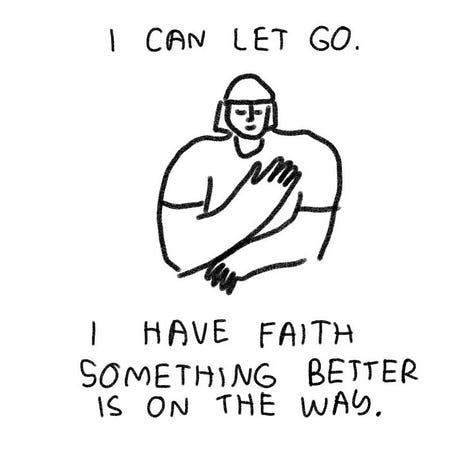
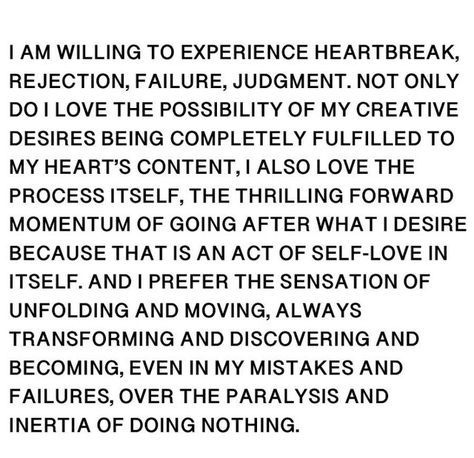
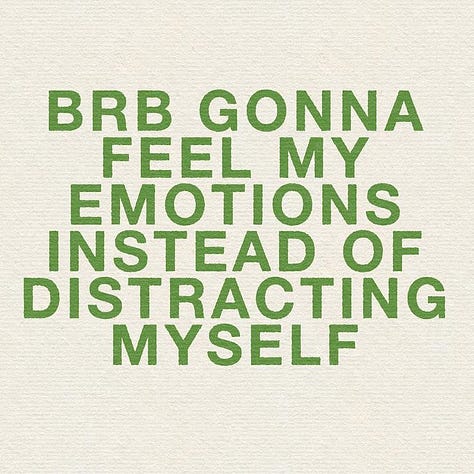
AC: What’d you say (earlier)? Choreographing the viewer?
LW: Yeah. The experience of seeing and witnessing art. I’m going to put you in your body, I’m going take you out of it. We’re going to travel.









